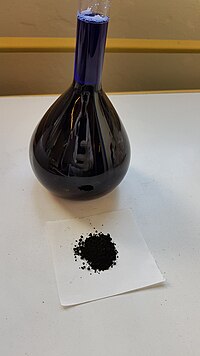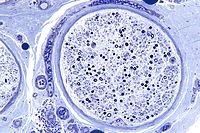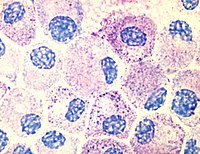
| |
| Names | |
|---|---|
| IUPAC name (7-amino-8-methylphenothiazin-3-ylidene)-dimethylammonium chloride | |
| Other names Toluidine blue O | |
| Identifiers | |
| CAS Number | |
| 3D model (JSmol) | |
| ChEBI | |
| ChEMBL | |
| ChemSpider | |
| ECHA InfoCard | 100.001.952 |
| MeSH | Tolonium+chloride |
| PubChem CID | |
| UNII | |
| CompTox Dashboard (EPA) | |
InChI
| |
SMILES
| |
| Properties | |
| Chemical formula | C15H16N3S |
| Molar mass | 270.374 g/mol |
| Except where otherwise noted, data are given for materials in their standard state (at 25 °C , 100 kPa).
| |

Toluidine blue, also known as TBO or tolonium chloride (INN) is a blue cationic (basic) dye used in histology (as the toluidine blue stain) and sometimes clinically.
Test for lignin
Toluidine blue solution is used in testing for lignin, a complex organic molecule that bonds to cellulose fibres and strengthens and hardens the cell walls in plants. A positive toluidine blue test causes the solution to turn from blue to blue-green. A similar test can be performed with phloroglucinol-HCl solution, which turns red.
Histological uses

Toluidine blue is a basic thiazine metachromatic dye with high affinity for acidic tissue components. It stains nucleic acids blue and polysaccharides purple and also increases the sharpness of histology slide images. It is especially useful today for staining chromosomes in plant or animal tissues, as a replacement for Aceto-orcein stain.
Toluidine blue is often used to identify mast cells, by virtue of the heparin in their cytoplasmic granules. It is also used to stain proteoglycans and glycosaminoglycans in tissues such as cartilage. The strongly acidic macromolecular carbohydrates of mast cells and cartilage are coloured red by the blue dye, a phenomenon called metachromasia.
Alkaline solutions of toluidine blue are commonly used for staining semi-thin (0.5 to 1 μm) sections of resin-embedded tissue. At high pH (about 10) the dye binds to nucleic acids and all proteins. Although everything in the tissue is stained, structural details are clearly visible because of the thinness of the sections. Semi-thin sections are used in conjunction with ultra-thin sections examined by electron microscopy.
Toluidine blue is also commonly used to stain frozen sections (rapid microscopic analysis of a specimen). Because time is of the essence for a frozen section, toluidine blue allows for the frozen section to be stained and reviewed in 10 to 20 seconds. The other staining method for frozen sections (rapid H&E) takes approximately 60 to 90 seconds.
The results depend on the studied organs:
- Mastocytes in purple
- Cartilage in purple
- Mucins in purple/red
- Nuclei in blue
It is used in forensic examination, renal pathology and neuropathology.
Clinical uses
The dye is sometimes used by surgeons to help highlight areas of mucosal dysplasia (which preferentially take up the dye compared to normal tissue) in premalignant lesions (e.g. leukoplakia). This can be used to choose the best site of the lesion to biopsy, or during surgery to remove the lesion to decide whether to remove more tissue from the margins of the excision defect or leave it behind.

See also
References
- Reitz, Nicholas (27 January 2021). "Lignification of tomato (Solanum lycopersicum) pericarp tissue during blossom-end rot development". Scientia Horticulturae. 276. doi:10.1016/j.scienta.2020.109759. S2CID 225141378.
- Sridharan, Gokul; Shankar, Akhil A (2012). "Toluidine blue: A review of its chemistry and clinical utility". J Oral Maxillofac Pathol. 16 (2): 251–5. doi:10.4103/0973-029X.99081. PMC 3424943. PMID 22923899.
- Carson, Freida L; Hladik, Christa (2009). Histotechnology: A Self-Instructional Text (3 ed.). Hong Kong: American Society for Clinical Pathology Press. p. 188. ISBN 978-0-89189-581-7.
- Sridharan G, Shankar A. "Toluidine blue: A review of its chemistry and clinical utility. J Oral Maxillofac Pathol. 2012 May-Aug; 16(2):251-255
- "Toluidine blue". Histalim. Archived from the original on 2018-07-01. Retrieved 2020-03-15.
- Olshaker, Jackson and Smock (2001). Forensic Emergency Medicine. Philadelphia: Lippincott, Williams and Williams. pp. 94–97. ISBN 0781731445.
- Nicholas, Susanne B; Basgen, John M; Sinha, Satyesh (2011). "Using stereologic techniques for podocyte counting in the mouse: shifting the paradigm". Am J Nephrol. 33 (Suppl 1): 1–7. doi:10.1159/000327564. PMC 3121548. PMID 21659728.
- Scully, Crispian; Porter, Stephen (22 July 2000). "ABC of oral health. Swellings and red, white, and pigmented lesions". BMJ (Clinical Research Ed.). 321 (7255): 225–8. doi:10.1136/bmj.321.7255.225. PMC 1118223. PMID 10903660.
Further reading
- Carson FL (1997) Histotechnology. A Self-Instructional Text. 2nd ed. American Society of Clinical Pathologists, Chicago.
- Green FJ (1990) The Sigma-Aldrich Handbook of Stains, Dyes and Indicators. Aldrich Chemical Company, Milwaukee, Wisconsin.
- Horobin RW, Kiernan JA, Eds (2002) Conn's Biological Stains. A Handbook of Dyes, Stains and Fluorochromes for Use in Biology and Medicine. 10th ed. BIOS, Oxford.
- Kiernan JA (2008) Histological and Histochemical Methods: Theory and Practice. 4th ed. Scion, Bloxham, UK.
- Sridharan, Gokul; Shankar, Akhil A (2012). "Toluidine blue: A review of its chemistry and clinical utility". J Oral Maxillofac Pathol. 16 (2): 251–5. doi:10.4103/0973-029X.99081. PMC 3424943. PMID 22923899.